There are a number of different plumbing valve types used to control the flow of water in a building. The pros and cons of each type are identified below.
Ball Valve
Ball valves are made with a rotating sphere that has a hole in it. In the open position, the hole in the sphere is in line with the pipe. When closed, the hole in the sphere is perpendicular to the pipe. The lever handle operates the valve, but also serves as an indicator for whether the valve is open or closed. When the lever is parallel to the pipe, the valve is open.
Ball valves do not allow for precise flow control because they usually have positive stops (0, 45, 90 degrees), but they do provide a very good seal in the closed position.
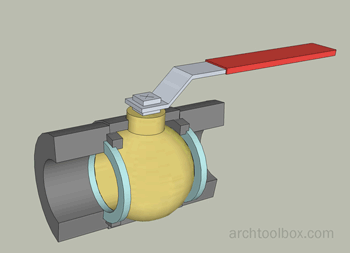
Gate Valve
Gate valves control water flow by raising or lowering the gate, which is generally a piece of metal. There is a wheel or knob at the top of a gate valve that controls the height of the gate - this, in turn, affects the flow of water. Unfortunately, the wheel doesn't provide any indication of whether the valve is open or closed, or to what extent.
Gate valves provide a reasonable seal, but they should not be used to adjust flow - they should be open or closed. Gate valves may not be very durable and are susceptible to corrosion, which will cause the valve to get stuck in the open or closed position.
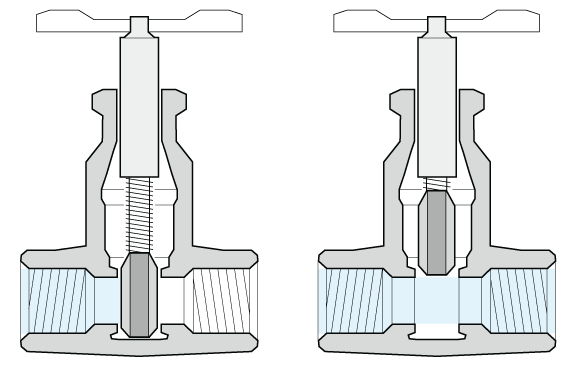
Butterfly Valve
Butterfly valves have a disc that is equal in size to the inside diameter of the pipe. This disc is attached to a lever handle that rotates the disc, which adjusts the flow of water. The main drawback to butterfly valves is that the control disc is always present within the flow of water (even when fully open) so there will always be a pressure drop when using them.
Butterfly valves allow for fairly precise control of flow. They typically rely on a gasket to provide a full seal, which can become a maintenance issue.
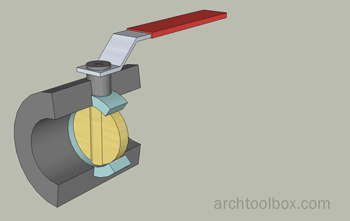
Diaphragm Valve
A diaphragm valve is similar to a gate valve in that there is a wheel or knob that moves an element in the valve fitting, which limits the flow of water. In a diaphragm valve, the element is a diaphragm that settles down over a saddle, thus stopping water flow. The diagram below is a weir-type diaphragm valve, where water passes over a weir. There is also a straight-type diaphragm valve, which doesn't force water over a weir.
Diaphragm valves are generally used as shutoff or stop valves.
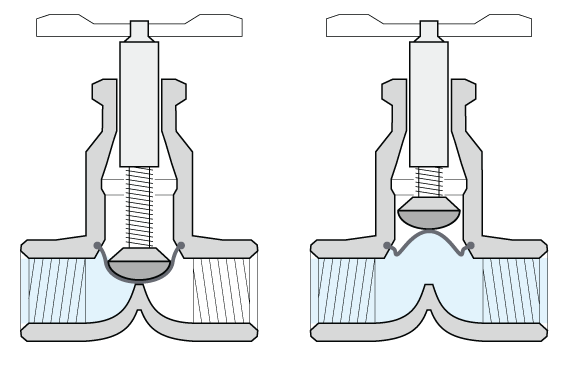
Globe Valve
Globe valves are used to throttle or limit the flow of water. They have a stopper that is raised and lowered by a wheel or knob on a shaft. The stopper seals into a baffle to stop flow. Globe valves are used in situations where the flow needs to be adjusted regularly, but also where the flow doesn't have to be fully open since the baffle restricts flow.
Globe valves get their name from the globe-like or ball-like appearance that the body of the valve has.
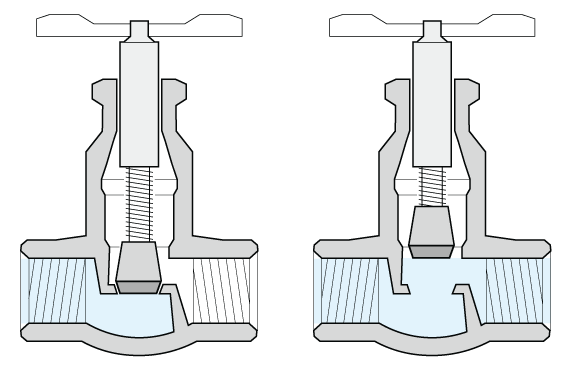
Check Valve
Check valves are used to keep water flowing in only one direction. They are generally not operational. A back-flow preventer is a type of check valve. A ball-check valve uses a ball to stop the flow of water in the wrong direction. A diaphragm-check valve has a rotating disc or rubber flap that is pushed to seal the opening in the event of flow in the wrong direction.
A stop-check valve is operational and allows a user to completely stop all flow - even flow in the correct direction. It will not allow backward flow when open.
Pressure Balanced Valve
Pressure balanced valves are used to maintain a constant temperature of water in domestic showers or bathtubs. A diaphragm within the valve allows the operator to set mixing of hot and cold water; however in the event of a pressure drop of cold water (for instance, if a toilet nearby is flushed), the diaphragm will shift to limit an excessive flow of hot water. Many jurisdictions require pressure balanced valves in domestic bathrooms and showers to prevent accidental scalding.
Zone Valve
Zone valves are used in hydronic heating and cooling systems to control the flow of water or steam. For instance, they may be provided in different rooms, different floors, or different dwelling units so that each space can have local control over the heating or cooling. In most applications, zone valves are electrically controlled and are connected to a thermostat so that automatic control is achieved.
Locking Valve
Almost any type of valve can be locked to avoid accidental or intentional opening or closing. However, valves with lever-type handles allow for more secure locking control. Locking valves provide aligning holes that a lock can be passed through to stop rotation of the handle. There are also locks designed to be attached to non-locking valves to prevent adjustment.
Solenoid Valve
Solenoid valves are electrically controlled valves that can offer precise on/off control via an automation system. Solenoid valves are used in buildings where an automation system controls the plumbing or HVAC system. Another common use is in irrigation systems where a computer controls the watering times or the amount of water to be applied.


